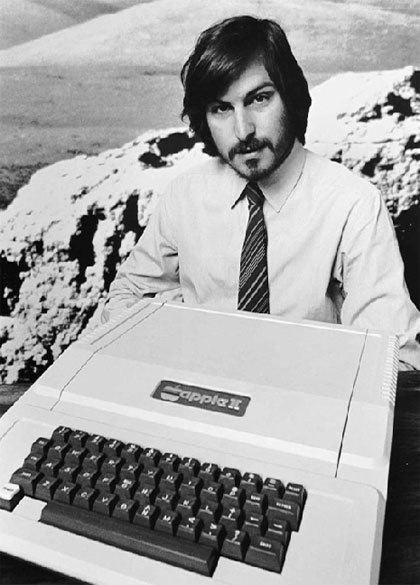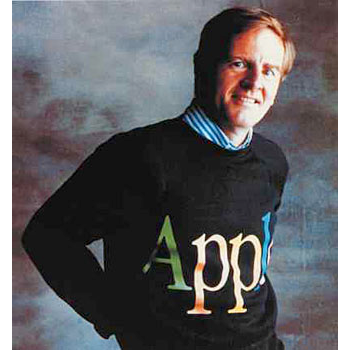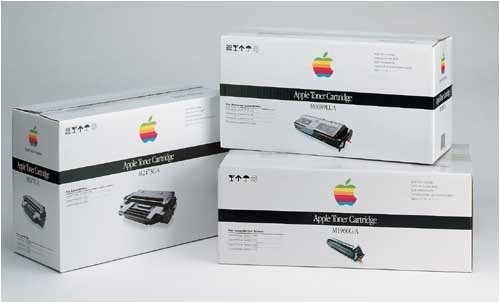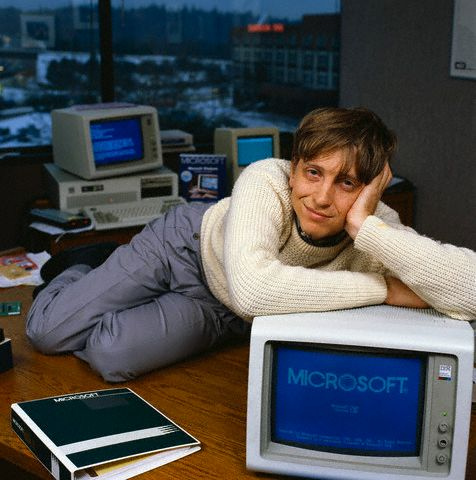Apple history from the beginning to the present
Apple's history is intricate and full of ups and downs, like the life of a rock star. The only thing that was not in it was, perhaps, stories with drugs and suicide. However, the obsession with the idea of making our life more comfortable and pleasant is it not analogous to heroin addiction? Is it possible to call a simple philistine a person who got hooked on this system under the name “innovation” and did not calm down until the entire civilized world planted it?

AppleInsider blog traced the entire life of the legendary company in its material: from a California garage, in which two Steve (Jobs and Wozniak) swarmed over the creation of their first computer, to triumphal presentations, which at a glance of millions of eyes a man in a black jumper and blue jeans gives the world new and new wonderful gadgets. This week the first part of the trilogy is published, where the early years of the company with its first conquests and defeats are considered. Start reading here or continue reading.
')
The founders of Apple, as you know, are two Californian guys Stephen Wozniak and Stephen Jobs (Steven Jobs). They were close friends of the institute, were interested in electronics and among their peers were reputed to be “nerds” and outsiders. After the institute, they maintained friendly relations, although their fate scattered across different companies in Silicon Valley (Wozniak got a job at Hewlett-Packard, and Jobs at Atari).
Wozniak was already captured by the idea of a revolutionary computing device and in 1976 developed a computer, which later became known as the Apple I. Jobs, however, looked at this process from a commercial point of view and urged Wozniak to start selling computers. As a result, on April 1, 1976, Apple Computer was launched.
Buyers did not take Apple I seriously enough, and real success came to the company only the following year, when the Apple II premiere took place at the local computer exhibition. Being the first personal computer dressed in a plastic case and displaying color graphics, the Apple II then made a strong impression on many. After the premiere of the device, the company was literally flooded with orders for the Apple II. Apple's continued success was promoted by the appearance in early 1978 of the Apple Disk II - the cheapest and most easy-to-use drive at that time.
Along with the increase in sales, the company itself grew, and by 1980 Apple staff already had several thousand employees. In addition, at that time, the company decided to start selling computers outside the United States. In order to improve management efficiency, Apple began to attract new managers and new investors who agreed to take seats on the board of directors. These elderly and conservative people believed that in order to increase the efficiency of the company, it should get rid of many of the employees who worked in it from the very beginning. No one dared to resist them, and Apple underwent a full-scale reshuffle.
In 1981, the situation deteriorated markedly. Due to the satiation of the market, computers have become increasingly difficult to sell, and Apple has begun to incur losses. As a result, in February it was decided to cut 40 jobs. In March of the same year, Steve Jobs was appointed Chairman of the Board of Directors of Apple.
After a historic visit to Xerox PARC in 1979, Jobs and several other engineers began developing the Lisa computer, which was to transform the personal computer market. However, Jobs turned out to be a poor project manager, and Mike Markkula, who was Apple’s president at the time and was one of the majority shareholders, was given the lead on Lisa. Jobs, who then owned 11% of the shares, decided not to sit idle and began to implement another project - Macintosh. At that time, his goal was to create a personal computer worth $ 500.

1981 was marked by the fact that IBM has released its first PC. Thanks to aggressive marketing and competent PC promotion, he quickly took dominant positions in the personal computer market. At that time, Jobs began to realize that it was time for Apple to "grow up", and realized that he was unlikely to be able to achieve this on his own.
In early 1983, Jobs began to persuade Pepsi-Cola President John Sculley to join his company. In April of the same year, his attempts were crowned with success, and Scully got the position of executive director of Apple. Jobs believed that Scully, with his experience and managerial skills, would help the company to grow, but he did not understand how this could be done. Subsequently, this venture cost Jobs his workplace.
It soon became clear to everyone that although Scully was a brilliant businessman, he didn’t understand the computer industry at all. As a result, almost immediately he lost his relationship with Jobs. As the Macintosh premiere approached, Jobs accelerated the pace of work. He hurried developers writing programs for this computer, realizing that otherwise he would suffer fiasco in the rapidly developing software market.

On January 22, 1984, during the third period of the Super Bowl Baseball Cup finals, Apple showed its legendary 60-second Macintosh commercial. This video, directed by the still not very famous Ridley Scott, was inspired by George Orwell’s 1984 novel, and described a dark future in which humanity was enslaved by IBM machines. Alternatively, it was proposed to free their individuality and choose a Mac. The display of this video, which has become a classic and forever included in the annals of advertising, has really significantly increased sales of Apple computers. However, by the end of 1984, these figures went down, as many were disappointed with the hardware of this device.
In early 1985, disagreements between Jobs and Scully escalated into full-blown conflict. Scully considered Jobs to be a dangerous person who could not be controlled, and Jobs claimed that Scully did not understand computers and didn’t even want to learn. In May of the same year, Jobs attempted to take control of Apple. He persuaded Scully to hold a business meeting in China on the day of the regular meeting of shareholders, and at that moment he tried to organize a coup in the company's management. As a result, Scully became aware of Jobs' intentions, and he stayed to take part in the meeting. After the inevitable fierce dispute between two opponents, the board of directors decided to get rid of one of them and vote on which of the rivals should remain in the company. In the end, the majority sided with Scully, who remained at the helm of Apple. On the same day, Steve Jobs was forced to resign.
After Scully took over power in May 1985, Apple dismissed one fifth of its employees in a few months - about 1,200 people. At the same time, for the second quarter of the same year, for the first time in history, the company reported losses. All these circumstances gave shareholders a reason to doubt the correctness of their decision to dismiss Jobs and the transfer of the scepter and power to John Scully.
Scully suffered another defeat when Apple started a confrontation with Microsoft gaining strength. For everyone, even for Bill Gates himself, it was obvious that the Windows 1.0 operating system was very similar to the Mac graphical user interface. In the end, Gates agreed to sign an agreement under which Microsoft will not use Mac technology in Windows 1.0. However, it did not say anything about subsequent versions of Windows. As a result of the fact that Scully fell into such a cunning legal trap, Apple managed to lose the exclusive rights to its own designed interface. Of course, numerous lawsuits between Apple and Microsoft soon followed, ending in nothing.

The appearance of two new products helped improve the position of the Mac: the LaserWriter, the first affordable PostScript laser printer for the Mac, and PageMaker, one of the first-ever office applications. Thanks to these two new products, Mac has become an ideal solution for offices and once again celebrated success in the market.
In 1987, Apple introduced the Mac II. This computer, which provides extensive hardware upgrades, has made the Macintosh model range a promising and powerful family of computers. Sales of "poppies" reached 50,000 units per month, which allowed Apple to return to the number of Wall Street favorites. In 1989, it was all said that the Mac would enter the new decade with its head held high, leaving Windows far behind.
However, this was not to be. By 1990, the market was crowded with many PC clones available in a wide variety of configurations. And Apple, in turn, sold only a limited number of "poppies". In late May, Microsoft introduced the Windows 3.0 operating system, which could run on any PC available on the market. For Apple, it is a very difficult time.

The only solution Apple saw was to license the Mac OS. While many believed that this could adversely affect the quality of the Mac or even increase the already high level of competition, it was obvious that Apple simply could not supply enough hardware and software to support the entire industry. There was also talk of porting the Apple operating system to Intel-based machines. However, Apple's new operating director, Michael Spindler, said that "it's too late to license the OS."
In late 1991, Apple introduced the first generation of its portable PowerBook devices, which initially had a rather impressive success. Work has also begun on a new type of PDA computer, which Apple called Newton. Scully immediately showed an interest in this device, and in August 1993, its development was completed. Nevertheless, the first generation of “Newtons” was distinguished by extremely low quality handwriting recognition and did not sell very well.

Next week we will continue our story and cover the period from 1993 to 2000. This gap was marked by a large number of significant events for Apple. Among the most important of them are: John Sculley’s resignation from the post of CEO, return to Steve Jobs, the emergence of the PowerMac G3, PowerMac G4 and iMac computers, the opening of the Apple Store, the launch of the iBooks service and the exit of the iTunes application.

AppleInsider blog traced the entire life of the legendary company in its material: from a California garage, in which two Steve (Jobs and Wozniak) swarmed over the creation of their first computer, to triumphal presentations, which at a glance of millions of eyes a man in a black jumper and blue jeans gives the world new and new wonderful gadgets. This week the first part of the trilogy is published, where the early years of the company with its first conquests and defeats are considered. Start reading here or continue reading.
')
The founders of Apple, as you know, are two Californian guys Stephen Wozniak and Stephen Jobs (Steven Jobs). They were close friends of the institute, were interested in electronics and among their peers were reputed to be “nerds” and outsiders. After the institute, they maintained friendly relations, although their fate scattered across different companies in Silicon Valley (Wozniak got a job at Hewlett-Packard, and Jobs at Atari).
Wozniak was already captured by the idea of a revolutionary computing device and in 1976 developed a computer, which later became known as the Apple I. Jobs, however, looked at this process from a commercial point of view and urged Wozniak to start selling computers. As a result, on April 1, 1976, Apple Computer was launched.
Buyers did not take Apple I seriously enough, and real success came to the company only the following year, when the Apple II premiere took place at the local computer exhibition. Being the first personal computer dressed in a plastic case and displaying color graphics, the Apple II then made a strong impression on many. After the premiere of the device, the company was literally flooded with orders for the Apple II. Apple's continued success was promoted by the appearance in early 1978 of the Apple Disk II - the cheapest and most easy-to-use drive at that time.
Along with the increase in sales, the company itself grew, and by 1980 Apple staff already had several thousand employees. In addition, at that time, the company decided to start selling computers outside the United States. In order to improve management efficiency, Apple began to attract new managers and new investors who agreed to take seats on the board of directors. These elderly and conservative people believed that in order to increase the efficiency of the company, it should get rid of many of the employees who worked in it from the very beginning. No one dared to resist them, and Apple underwent a full-scale reshuffle.
In 1981, the situation deteriorated markedly. Due to the satiation of the market, computers have become increasingly difficult to sell, and Apple has begun to incur losses. As a result, in February it was decided to cut 40 jobs. In March of the same year, Steve Jobs was appointed Chairman of the Board of Directors of Apple.
After a historic visit to Xerox PARC in 1979, Jobs and several other engineers began developing the Lisa computer, which was to transform the personal computer market. However, Jobs turned out to be a poor project manager, and Mike Markkula, who was Apple’s president at the time and was one of the majority shareholders, was given the lead on Lisa. Jobs, who then owned 11% of the shares, decided not to sit idle and began to implement another project - Macintosh. At that time, his goal was to create a personal computer worth $ 500.

1981 was marked by the fact that IBM has released its first PC. Thanks to aggressive marketing and competent PC promotion, he quickly took dominant positions in the personal computer market. At that time, Jobs began to realize that it was time for Apple to "grow up", and realized that he was unlikely to be able to achieve this on his own.
In early 1983, Jobs began to persuade Pepsi-Cola President John Sculley to join his company. In April of the same year, his attempts were crowned with success, and Scully got the position of executive director of Apple. Jobs believed that Scully, with his experience and managerial skills, would help the company to grow, but he did not understand how this could be done. Subsequently, this venture cost Jobs his workplace.
It soon became clear to everyone that although Scully was a brilliant businessman, he didn’t understand the computer industry at all. As a result, almost immediately he lost his relationship with Jobs. As the Macintosh premiere approached, Jobs accelerated the pace of work. He hurried developers writing programs for this computer, realizing that otherwise he would suffer fiasco in the rapidly developing software market.

On January 22, 1984, during the third period of the Super Bowl Baseball Cup finals, Apple showed its legendary 60-second Macintosh commercial. This video, directed by the still not very famous Ridley Scott, was inspired by George Orwell’s 1984 novel, and described a dark future in which humanity was enslaved by IBM machines. Alternatively, it was proposed to free their individuality and choose a Mac. The display of this video, which has become a classic and forever included in the annals of advertising, has really significantly increased sales of Apple computers. However, by the end of 1984, these figures went down, as many were disappointed with the hardware of this device.
In early 1985, disagreements between Jobs and Scully escalated into full-blown conflict. Scully considered Jobs to be a dangerous person who could not be controlled, and Jobs claimed that Scully did not understand computers and didn’t even want to learn. In May of the same year, Jobs attempted to take control of Apple. He persuaded Scully to hold a business meeting in China on the day of the regular meeting of shareholders, and at that moment he tried to organize a coup in the company's management. As a result, Scully became aware of Jobs' intentions, and he stayed to take part in the meeting. After the inevitable fierce dispute between two opponents, the board of directors decided to get rid of one of them and vote on which of the rivals should remain in the company. In the end, the majority sided with Scully, who remained at the helm of Apple. On the same day, Steve Jobs was forced to resign.
After Scully took over power in May 1985, Apple dismissed one fifth of its employees in a few months - about 1,200 people. At the same time, for the second quarter of the same year, for the first time in history, the company reported losses. All these circumstances gave shareholders a reason to doubt the correctness of their decision to dismiss Jobs and the transfer of the scepter and power to John Scully.
Scully suffered another defeat when Apple started a confrontation with Microsoft gaining strength. For everyone, even for Bill Gates himself, it was obvious that the Windows 1.0 operating system was very similar to the Mac graphical user interface. In the end, Gates agreed to sign an agreement under which Microsoft will not use Mac technology in Windows 1.0. However, it did not say anything about subsequent versions of Windows. As a result of the fact that Scully fell into such a cunning legal trap, Apple managed to lose the exclusive rights to its own designed interface. Of course, numerous lawsuits between Apple and Microsoft soon followed, ending in nothing.

The appearance of two new products helped improve the position of the Mac: the LaserWriter, the first affordable PostScript laser printer for the Mac, and PageMaker, one of the first-ever office applications. Thanks to these two new products, Mac has become an ideal solution for offices and once again celebrated success in the market.
In 1987, Apple introduced the Mac II. This computer, which provides extensive hardware upgrades, has made the Macintosh model range a promising and powerful family of computers. Sales of "poppies" reached 50,000 units per month, which allowed Apple to return to the number of Wall Street favorites. In 1989, it was all said that the Mac would enter the new decade with its head held high, leaving Windows far behind.
However, this was not to be. By 1990, the market was crowded with many PC clones available in a wide variety of configurations. And Apple, in turn, sold only a limited number of "poppies". In late May, Microsoft introduced the Windows 3.0 operating system, which could run on any PC available on the market. For Apple, it is a very difficult time.

The only solution Apple saw was to license the Mac OS. While many believed that this could adversely affect the quality of the Mac or even increase the already high level of competition, it was obvious that Apple simply could not supply enough hardware and software to support the entire industry. There was also talk of porting the Apple operating system to Intel-based machines. However, Apple's new operating director, Michael Spindler, said that "it's too late to license the OS."
In late 1991, Apple introduced the first generation of its portable PowerBook devices, which initially had a rather impressive success. Work has also begun on a new type of PDA computer, which Apple called Newton. Scully immediately showed an interest in this device, and in August 1993, its development was completed. Nevertheless, the first generation of “Newtons” was distinguished by extremely low quality handwriting recognition and did not sell very well.

Next week we will continue our story and cover the period from 1993 to 2000. This gap was marked by a large number of significant events for Apple. Among the most important of them are: John Sculley’s resignation from the post of CEO, return to Steve Jobs, the emergence of the PowerMac G3, PowerMac G4 and iMac computers, the opening of the Apple Store, the launch of the iBooks service and the exit of the iTunes application.
Source: https://habr.com/ru/post/105646/
All Articles